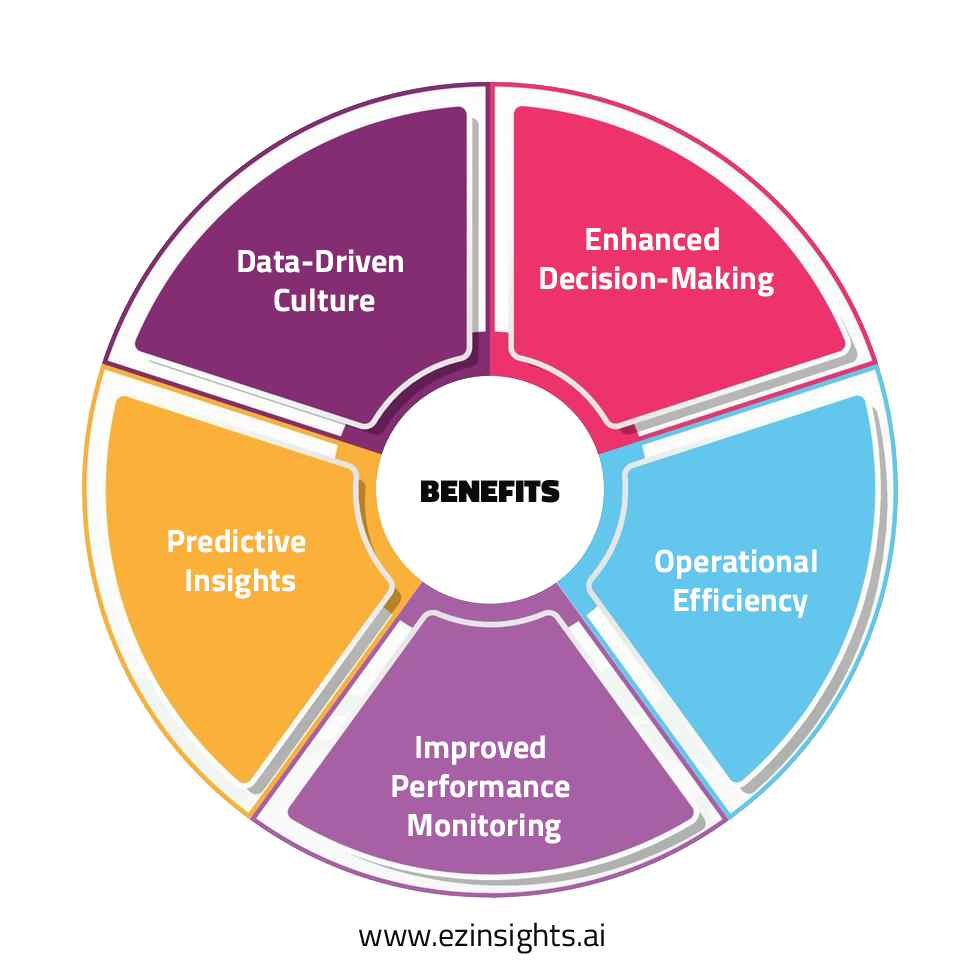In the current dynamic digital environment, companies are always looking for new and creative methods to use data to make well-informed decisions. Artificial Intelligence (AI) dashboards are a shining example of efficiency and insight amidst the multitude of technologies available. We examine the features, advantages, and significant influence artificial intelligence dashboards have on contemporary corporate operations as we delve into the transformative potential of these tools.
Artificial Intelligence Dashboards are a crucial combination of data visualization with artificial intelligence (AI). They function as dynamic user interfaces that enable users to understand large, complex datasets, extract useful insights, and make well-informed decisions. These dashboards use artificial intelligence (AI) algorithms to analyse enormous amounts of data quickly and efficiently, presenting the distilled information in an easily readable way. Artificial Intelligence Dashboards serve a wide range of users, from executives looking for strategic insights to operational staff keeping an eye on real-time indicators, thanks to their user-friendly interfaces and interactive capabilities.
Fundamentally, machine learning algorithms are used by artificial intelligence dashboards to process data and produce prescriptive or predictive insights. By identifying patterns, trends, and anomalies in datasets, these algorithms help users make better decisions by helping them predict future events. Organizations may more accurately and quickly anticipate market trends, spot possible hazards, and seize new opportunities by incorporating AI-powered prediction models into dashboards.
Artificial Intelligence Dashboards also promote a mutually beneficial partnership between human knowledge and machine intelligence, enhancing users’ analytical skills and enabling smooth teamwork. These dashboards may extract unstructured data from sources like social media, customer reviews, and news articles using natural language processing (NLP) and sentiment analysis. This allows them to provide priceless insights into consumer preferences, market sentiment, and brand impression. Users may quickly sort through enormous volumes of textual data, find hidden patterns, and derive useful insights to guide strategic decision-making by utilizing AI-driven text analytics.
Understanding Artificial Intelligence Dashboards
Artificial Intelligence dashboards are centralized platforms that combine data from several sources and produce actionable insights by applying advanced analytics techniques. These insights facilitate easy interpretation and enable stakeholders to make swift data-driven decisions through intuitive visualizations.
The Evolution of Artificial Intelligence Dashboards
Originally, dashboards were meant to provide static representations of data, offering minimal interactivity and analytics. However, with the advent of AI, there has been a revolutionary change. Dashboards can now use the power of machine learning algorithms to analyse data dynamically, uncovering trends, patterns, and anomalies in real-time.
Key Features of Artificial Intelligence Dashboards
Advanced Analytics:
Advanced analytical models, including as predictive analytics, natural language processing (NLP), and anomaly detection, are used by artificial intelligence dashboards to glean insightful information from data.
Personalization:
By customizing insights to the unique requirements and preferences of individual users or user groups, these dashboards provide individualized user experiences.
Real-Time Monitoring:
Artificial Intelligence Dashboards enable proactive decision-making by providing real-time updates on critical parameters through continuous stream monitoring.
Integration Capabilities:
To ensure thorough data coverage, they effortlessly link with a variety of data sources, including as databases, cloud storage, APIs, and Internet of Things devices.
Interactive Visualizations:
Artificial Intelligence Dashboards enable deeper understanding of complicated datasets and promote data exploration through interactive charts, graphs, and maps.
Customizable Alerts:
Users can set up alerts to be triggered when significant changes or anomalies in the data occur, based on predetermined criteria or conditions.
Benefits of Artificial Intelligence Dashboards

Enhanced Decision-Making:
Artificial Intelligence Dashboards enable decision-makers to create strategies with higher certainty and accuracy by combining massive volumes of data into actionable insights.
Operational Efficiency:
Tasks related to data analysis and visualization can be automated to improve productivity and streamline workflows, saving time and money.
Improved Performance Monitoring:
Organizations may track key performance indicators (KPIs) in real-time with the use of artificial intelligence dashboards, which allows for prompt actions to solve new issues or take advantage of opportunities.
Predictive Insights:
Artificial Intelligence Dashboards use predictive analytics to project future trends and results, giving businesses the ability to remain ahead of the curve and foresee changes in the market.
Data-Driven Culture:
Artificial Intelligence Dashboards encourage a culture of openness, responsibility, and creativity by encouraging data-driven decision-making at all organizational levels.
Competitive Advantage: Businesses that use AI dashboards to their fullest potential acquire a competitive advantage by using data as a tactical tool to spur expansion and profitability.
Use Cases of Artificial Intelligence Dashboards
Marketing Optimization:
Artificial intelligence dashboards use consumer behaviour, demographics, and preferences analysis to find high-value customers, tailor content distribution, and improve marketing campaigns.
Financial Forecasting:
Artificial Intelligence Dashboards produce precise forecasts by examining past financial data and market trends. This helps with risk management, investment planning, and budgeting.
Supply Chain Management:
Artificial Intelligence Dashboards track supplier performance, demand projections, and inventory levels to maximize supply chain efficiency, save expenses, and reduce risks.
Healthcare Analytics:
Artificial intelligence dashboards are used in the healthcare industry to examine patient data, clinical results, and treatment efficacy to improve patient care, diagnosis, and resource allocation.
Human Resources Analytics:
Artificial Intelligence Dashboards allow HR teams to make data-driven decisions about hiring, retaining, and developing personnel by monitoring worker performance, engagement levels, and workforce demographics.
Challenges and Considerations
Although AI dashboards provide many advantages, there are certain difficulties in putting them into practice. To guarantee the moral and responsible application of AI technologies, organizations need to address issues with data privacy, security, and governance. In addition, non-technical people may find it difficult to apply AI algorithms due to their complexity, which calls for proper training and assistance.
Conclusion
Artificial Intelligence Dashboards are excellent at providing prescriptive insights, pointing people in the direction of the best actions based on recommendations derived from data. These dashboards use algorithms for reinforcement learning, which allow them to iteratively improve their recommendations over time in response to changing conditions and user preferences. AI-powered prescriptive analytics enable businesses to take advantage of opportunities and proactively manage risks, whether they are improving customer experiences, supply chain operations, or marketing tactics.
Additionally, Artificial Intelligence Dashboards put the user experience first, providing features that can be customized and intuitive interfaces to meet a range of user preferences and corporate needs. Users may easily create dashboards to display pertinent metrics, KPIs, and visualizations by dragging and dropping the functionality, allowing them to adapt the interface to their own responsibilities and goals. Furthermore, users may engage with data interactively with AI-powered data exploration tools, filtering datasets, delving into minute details, and quickly gaining actionable insights.
Artificial Intelligence Dashboards, which democratize access to actionable insights and enable enterprises to use data as a strategic asset, represent a paradigm shift in data-driven decision-making. These dashboards give users the confidence and clarity to traverse the complexity of today’s corporate environments by combining the power of artificial intelligence and data visualization. Artificial intelligence dashboards are essential tools for data-driven enterprises, since they can be used to drive innovation, improve customer experiences, and optimize operational efficiency. These tools may also be used to accelerate growth and create a sustainable competitive edge. Artificial Intelligence Dashboards have almost infinite potential to transform decision-making procedures and open new avenues as AI develops and progresses.
FAQs
How do Artificial Intelligence Dashboards improve performance optimization?
Artificial Intelligence Dashboards utilize advanced algorithms to analyze vast datasets in real-time, providing actionable insights into performance metrics. By identifying trends, anomalies, and opportunities for improvement, these dashboards empower organizations to make data-driven decisions that optimize performance across various aspects of their operations.
What types of performance metrics can be monitored and optimized using AI Dashboards?
AI Dashboards can monitor and optimize a wide range of performance metrics, including but not limited to sales revenue, customer satisfaction scores, website traffic, operational efficiency, and employee productivity. These dashboards can also track key performance indicators (KPIs) specific to each industry or business function, enabling organizations to focus on areas that directly impact their success.
How does Artificial Intelligence contribute to predictive performance optimization?
Artificial Intelligence enhances performance optimization by leveraging predictive analytics to forecast future outcomes based on historical data patterns. By analyzing trends and identifying correlations, AI algorithms can anticipate potential issues or opportunities before they arise, allowing organizations to proactively adjust their strategies and resources to achieve optimal results.
Can Artificial Intelligence Dashboards integrate with existing systems and tools?
Yes, most AI Dashboards are designed to seamlessly integrate with existing systems and tools, such as enterprise resource planning (ERP) software, customer relationship management (CRM) platforms, and data warehouses. This integration enables organizations to leverage their existing data infrastructure while harnessing the advanced analytical capabilities of AI Dashboards to optimize performance across the board.

Milan Desai
Chief Technology Officer
Milan Desai has more than 20 years of industry experience in working with clients to solve business problems. Passionate about leveraging technology for improving the quality of life and optimize the use of resources. Currently, working on utilizing data to drive business decision making process and user understanding of key metrics that drive the organization and markets in general. Co-founder of EzDataMunch – the first BI Apps store in the world.

